Review by Chris Rennirt
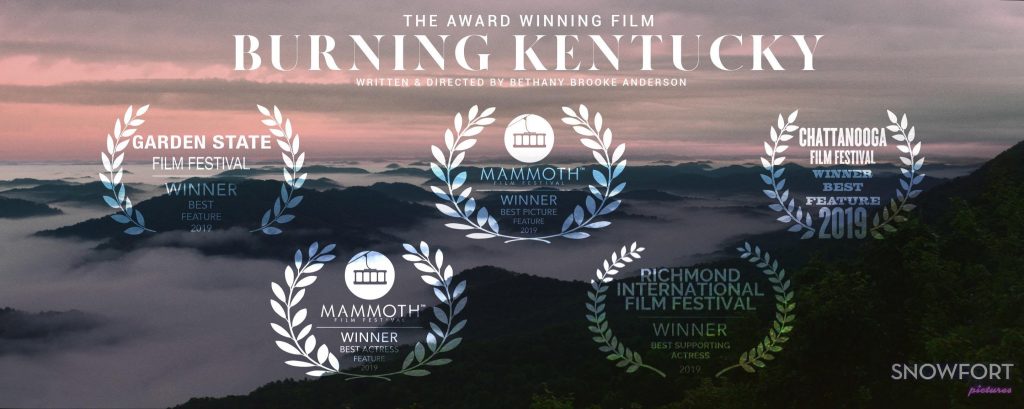
I recently attended the Flyover Film Festival in my hometown of Louisville, Kentucky. This year’s festival featured six films, all helmed by female directors, with all films accepted based on their quality and a required connection to Kentucky. (Yes! This year, all of the accepted films were directed by women!) Burning Kentucky, a film seven years in the making with firm roots in the Commonweath, is the one I had the great pleasure of seeing. Directed, written, and produced by Kentucky native Bethany Brooke Anderson, it’s the story of a young woman who searches for the missing pieces of a mysterious event that killed her family years earlier. Juxtaposed and intermingled are stories of the people who, in some way, are a part of the mystery. With all of this, we have a powerful story of revenge, forgiveness, love, hate, hope and despair – a real-world folktale for the times, bringing to light the darker underpinnings of the human condition, in an often beautiful way. As director Bethany Brooke Anderson says herself, in an interview with Lexington, Kentucky’s Channel 18 news, “This is not a light romp in the park.”
“My priority has always been to make Kentucky look like the magical place that it is.” ~ Bethany Brooke Anderson
Shot on location in Harlan, Kentucky and towns across the state, with the beauty of valleys, hollows, cloud-topped mountains and native wildlife, Burning Kentucky gets high production values as a gift from nature. Director Bethany Brooke Anderson smartly makes the most of it, with prolonged focus on everything in the Appalachian environment. The beauty of nature, against the ugliness of humanity at its worst, are thematic and metaphorical, making the story’s characters and events all the more emphasized and tragic. The focus on environment also conveys a strong sense of setting and location, most effective in a story that needs us to know its uniqueness as part of the storytelling. Sometimes scenes of nature are dreamlike and surreal, as if ironically part of a fairy tale, contrasting even more with the movie’s reality. In one scene, a character stands on the dock of a fog-shrouded lake, in an atmosphere almost ethereal and otherworldly. As director Bethany Brooke Anderson said in an interview with Ace Weekly, “My priority has always been to make Kentucky look like the magical place that it is.” Showcasing the beauty of Kentucky so well, indeed she does!

The cloud-topped Appalachian mountains show off Kentucky’s natural magic.
As the movie unfolds, viewers are given pieces of the mystery (in flashbacks and memories) as clues – clues confusing at first, later falling into the linear plot easily albeit unexpectedly. As a great credit to Bethany Brooke Anderson, nothing was predictable; everything took me by surprise, just as characters in the story experienced the events themselves. Whereas it is easy to make a movie that follows a straight path to the end, it is not so easy to intermingle the past with the present (punctuated with surreal imagery) making it all converge coherently in the end. As a director, Bethany Brooke Anderson takes a daring path to the end, challenging us to stay with her, getting us there all the better doing so.

Emilie Dhir as Aria
Emilie Dhir makes her debut as an actress in Burning Kentucky, as Aria (the one I expected to be the main character). In the movie, Dhir gives Aria the essence of innocence, gentility and beauty, as a human contrast to what are otherwise opposing elements in the film. Just as other characters condemn and devalue Aria for her social status as a “bottom” person, viewers refuse to see her as such from her appearance and perceived purity, appearing ironically angelic against the seemingly more unsavory (or demonic) elements around her. This conflict of perception and labeling involves the viewer in the movie, within its featured social context, most effectively. Dhir, as an actress, makes Aria believably restrained and subtle, even in dramatic, violent moments, finally surprising us with what we don’t expect. With talents that seem natural for her, Dhir becomes all the more powerful understating emotion, communicating more with less: a simple gaze, a pensive expression, a tone of voice, or silence. With a calm force of acting, Emilie Dhir makes a powerful debut.
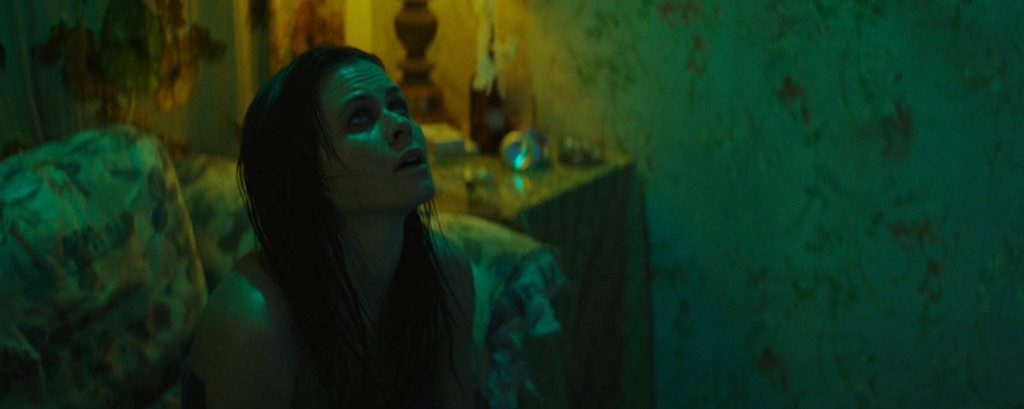
In Burning Kentucky, Jolene (Augie Duke) searches for hope in a place where hope doesn’t exist.
Augie Duke (Bad Kids Go to Hell, Exit 0) delivers a stellar performance as Jolene, a drug-addicted “tramp” of the town, with no family, no home, and no possessions – other than what she wears. With outstanding power of emotion, Augie elevates a minor character to extraordinary relevance. With Augie, Jolene is a vibrant personality in a movie that is otherwise dark and “American” gothic by design; with this, she creates another ironic but effective contrast of character and environment, as the movie’s spotlight example. Augie shows us a hopeful humanness in Jolene with which we can identify and for whom we can feel empathy – a humanness with depth, dimension, and familiarity, seen easily through the exterior of her dysfunctional character. Augie puts everything we need to see to see on her face, in her eyes, with authenticity we feel. Played the wrong way, Jolene could have been obnoxious, deserving of her fate, ultimately dispensable and forgettable. Augie, however, gives us a Jolene who is vulnerable and likable, challenging our expectations to label and stereotype her as the movie says we should.
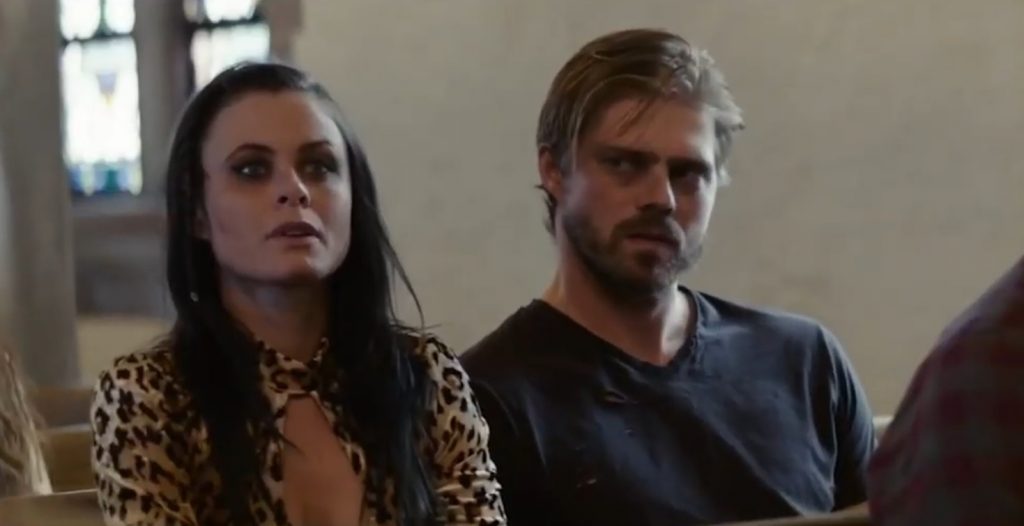
Augie Duke (as Jolene) and Nathan Sutton (as Rule)
Not the typical hardened, wasted character without potential or heart, more of a victim of circumstances and those who exploit her, Jolene longs to sober up, give up drugs, and escape her worthless life. But her boyfriend Rule (or the one she’s currently shacking up with) exploits her, controlling her with reminders of her worthlessness – telling her that she, like him, is (and always will be) a “piece of shit.” Augie Duke makes Jolene the perfect tragic character, hopeful, yet vulnerable, destroyed by a hopeless environment and those who abuse her. In a movie like Burning Kentucky, an actor must shed their vanity, leaving pretentiousness behind. For the success of the characters portrayed, they must forgo makeup, freshly-shampooed and carefully-styled hair, and the cleanliness of privilege; Augie gets gritty, as the role requires, truly becoming her character – raw, uncontrived, and one to remember. As a testament to her talents, Augie has already won Best Supporting Actress at the Richmond International Film Festival and Best Actress at the Mammoth Film Festival in California. With Augie’s powerful performance, more awards are sure to follow!
“I will never forgive anything that happened that night.” ~ Jaxon
It is interesting that Jolene (the town whore as some would call her) is the only character in the movie who has hope, in any amount, at any time. She is beaten down only by the weight of such negativity around her. Other characters exist in their circumstances, resigned to the bleak, narrow path they have always taken, mostly seeking revenge, reliving guilt, and/or lamenting over the past. This is, however, not a flaw of the movie. It is, rather, an intense and ultra-realistic view of life as it is for many people, in Eastern Kentucky or elsewhere. It is, rather, a power point of character portraits, with impact, insight and value.
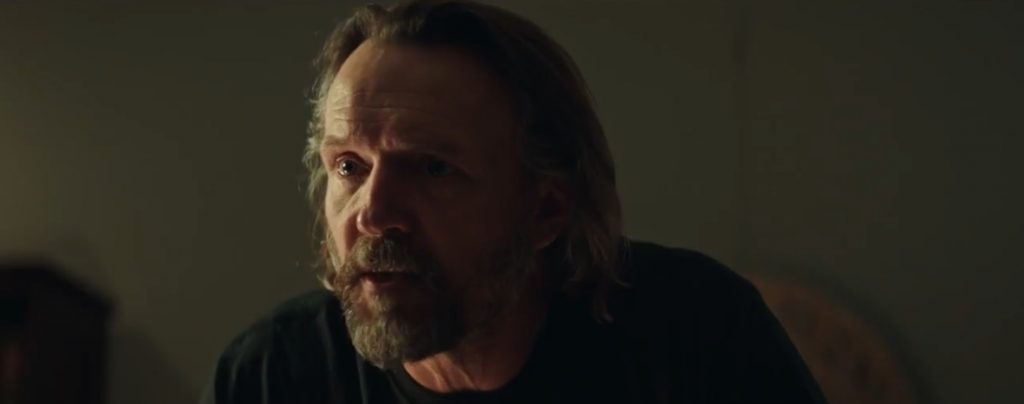
John Pyper-Ferguson as Jaxon
Veteran actor John Pyper-Ferguson is Jaxon – the alchoholic sheriff of the town, and personification of regret, guilt and self-loathing. (He even hates his own son Rule, because they are so much alike.) When the local preacher asks Jaxon how he’s doing, he responds with a list of problems that frame his life with misery: a dead wife, a drug-addicted son “shacked up” with a whore in his dead mother’s house, a dead-end job that pays him too little money, and more. Added to this is a dark secret in his life – a secret that doubles as the story’s overarching mystery. Pyper-Ferguson aces the role; with a powerful performance and seasoned skill, the complexity of Jaxon’s tragic character is brought to life.
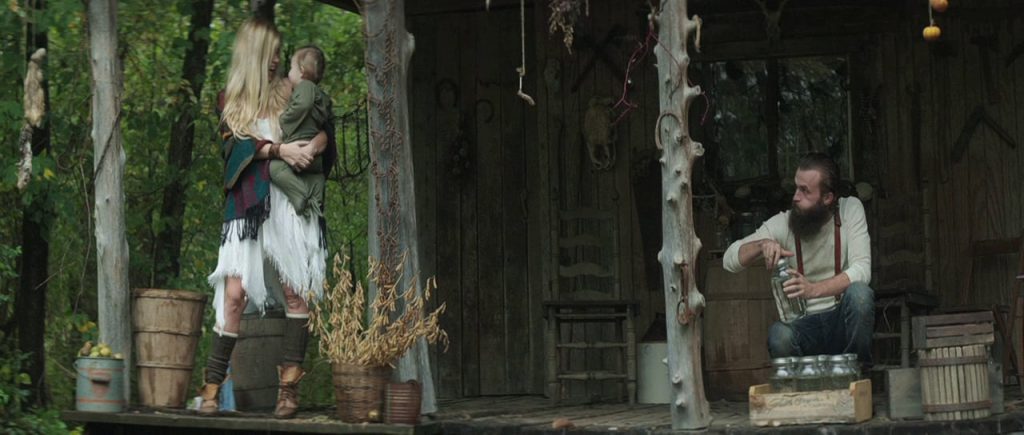
Director, writer, producer Bethany Brooke Anderson (left) in the role of Ari’s mother
The local preacher, Abe (played by Andy Umberger), is a character adding another layer of small-town reality to Burning Kentucky. If there is anyone in the town we would expect to accept everyone, including the “bottom people,” the preacher is the man. Does he? Does the preacher ask the townsfolk to put aside their judgement of fellow humans and accept us all as equals, helping one another as the Lord would surely expect? You might be surprised. That’s not all that might surprise you about this preacher. He’s also a lot more complex than we expect, with great effective irony added! Umberger fleshes out the character in his limited scenes, making the preacher more than the surface-level “man of God” he might have been.

Nick McCallum as Wyatt
Wyatt (Nick McCallum) and Rule (Nathan Sutton) are brothers about as dissimilar as siblings from the same parents could be. Rule is a son who spends his days “shacked up” with a tramp, doing drugs, emotionally-abusing the tramp (and giving her drugs) to keep her from leaving. Rule is as repulsive in character as he is physically filthy. Wyatt is a son who is a gentleman – respectable and clean cut, more often refusing to use stereotypes for judgement, defying his culture. Unlike Jolene, he is humanity with confidence, in a place where little exists elsewhere. Unlike Jolene, his character is one we expect to be good from the moment we see him, because he looks good; because we, as viewers, apply stereotypes too. With a love interest (and one I won’t reveal) and his good character, Wyatt could be a knight in shining armor in a backwoods fairy tale – the type where evil is real and dangerous. Be is he? Strong performances from Nick McCallum and Nathan Sutton add believable key characters, further supporting contrast as a thematic element.
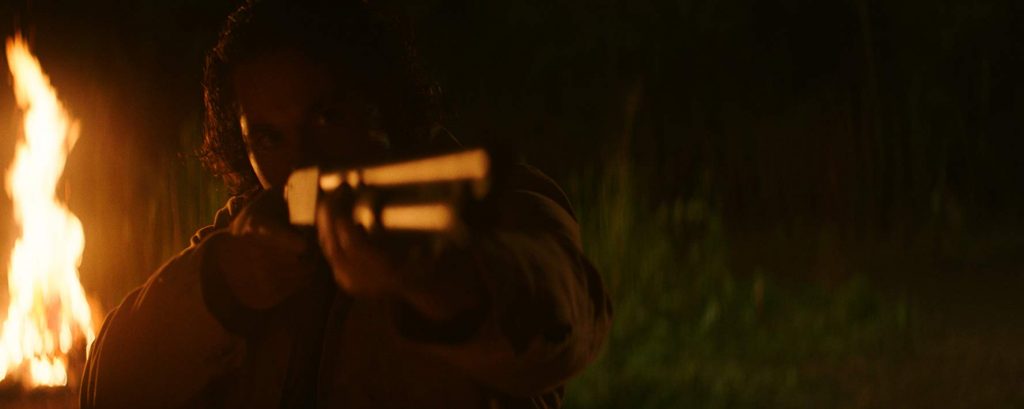
“I will never forgive anything that happened that night.”
To back up a bit, I actually felt bad having made a judgement about Jolene the moment I saw her. It still bothers me. Burning Kentucky may indeed have different affects on different people, but the final effect for all is a deeper insight into ourselves as viewers. Watching the movie, if we are honest and introspective, we may find ourselves being, for a moment, the very things we dislike in the characters. We may indeed find ourselves being just as human.
Burning Kentucky is a movie with no main character. Most characters get more or less the same screen time, and everyone is equally important as a piece of the puzzle and the story overall. There is no protagonist, no hero or heroine to save the day. There is no one to save anyone from anything, although everyone needs saving. Although I kept wanting to see Aria as the main character, I could find no reason to justify it. But, does the lack of a central character create a problem? No. Bethany Brooke Anderson clearly knew her vision and made a movie that functions as a collage of characters, all adding as much to the movie’s context of humanness as they do to the plot as a series of events. In that sense, all of the characters are central and equally important.
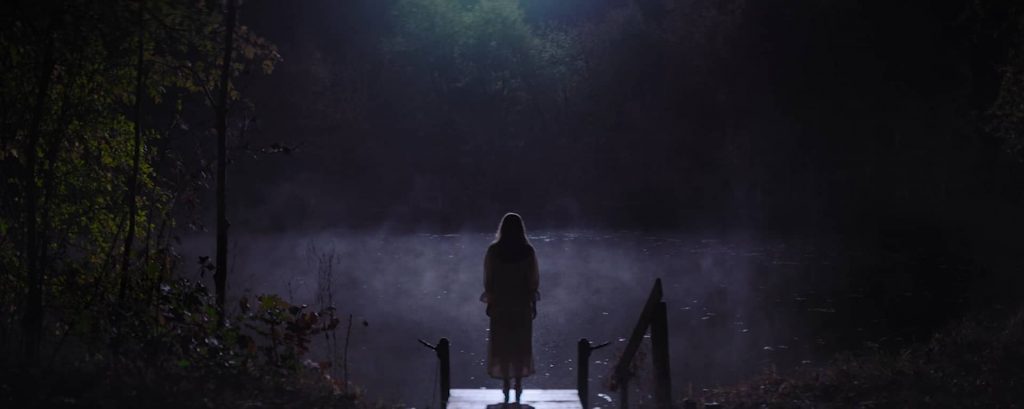
One of many magical moments in Burning Kentucky
What makes Burning Kentucky specific to Kentucky is the folktale that it is – one about Appalachia, backwoods moonshine stills, and “bottom people” who live in fear of their would-be neighbors who hate them. It is Kentucky as a stereotype, a reality, a fairy tale perhaps, but more often as a truth about universal humanness. As a microcosm of fictional Appalachian folklore, it speaks to a macrocosm of humanity everywhere. As for the meaning of the movie’s title, I see it as a metaphorical motif of guilt and cleansing of the soul – an antithetical parallel of symbolism, subtle and poetic.
“The audience should be prepared for a sad story painted with a beautiful brush, with Kentucky at its heart.” ~ Director, writer, producer Bethany Brooke Anderson
Burning Kentucky is a small-budget film with the look and feel of a big budget blockbuster. Intense and powerful, it’s more than one not to miss; it’s one to look for and seek out – one to Google and find out where it’s showing now! It has already won Best Feature Film and Best Actress at the Mammoth Film Festival (Augie Duke), Best Feature Film at the Chattanooga Film Festival, Best Narrative Feature Film at the Garden State Film Festival, and Best Supporting Actress (Augie Duke) at the Richomond International Film Festival. (Yes! I did mention Augie Duke as a winner twice!) Director Bethany Brooke Anderson tells us that a major distribution company has picked up the movie; from that, we suppose it should be available everywhere soon enough. In the meantime, stay tuned to Space Jockey Reviews for all the latest Burning Kentucky news and updates!
Chris Rennirt (the author of this review) is a movie critic and writer in Louisville, Kentucky, as well as editor in chief at Space Jockey Reviews. He has been a judge at many film festivals, including Macabre Faire Film Festival and Crimson Screen Film Fest, and he attends horror and sci-fi conventions often. Chris’ movie reviews, articles, and interviews are published regularly on Space Jockey Reviews and in Effective Magazine. His mission statement (describing his goals as a movie critic and philosophy for review writing) can be found on the “Mission” page, here at SJR. For more information about Chris Rennirt (including contact details, photos, and more), click here.
You may also like these!











Your review is spot-on! The movie was so powerful, culminating in the “forgive you” scene. So intense was this that I burst into tears with the humanity involved Emilie Dhir and Augie Duke are forces to be reckoned with! I must say I was in a trance watching Emilie from the first sight of her. Augie pulls off her beautiful tramp life flawlessly and with great depth and perception. This movie has big impact on me, and it succeeds on many levels. Every actor or actress seems like that very person – the talent and film-making and the breath-taking Kentucky lands. ABSOLUTELY STUNNING MOVIE! BRAVO TO ALL! This is a short review in no-way adequate for the vastness of this complex movie.
Can we just sum up this awesome production by saying that this is an absolutely amazing piece of cinematic artistry? It depicts common, tragic, terminally-flawed people in verses of ironically-ethereal (and sometimes violent) on-screen poetry. Much like a movie companion to Aaron Copeland’s “Fanfare for the Common Man,” the banal and forgotten become elevated to utmost magnificence, with redemption (if not revenge) well-deserved. As a fitting contrast, those who are the worst get the poetic comeuppance that is their fate, more than a mere consequence of their actions. Most reviewers are unable to flesh out the underpinnings of such a classic fairy-tale reality, but you certainly do, Chris Rennirt. Thanks for your service as a standout movie critic who shines light on otherwise unnoticed gems; we need more professionals like you to point out what most people do not…or cannot.
This was a flawed but powerful film. I want to talk about Augie Duke who has been mentioned several times as superb in this film. She literally enacts the pain of hope and doom. She keeps winning at small film festivals. Why is she not more well-known by now–she has a gift.
This film is one of two I suggest as a must see. The other being a love song for Bobby Long.